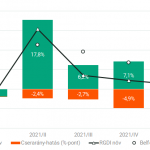
Konya, Istvan
2018, Palgrave Macmillan
This book studies the economic growth and development of four Visegrad economies (Czech Republic, Hungary, Poland and Slovakia) between 1995-2014. The author uses a neoclassical growth model with distortions (wedges) to identify the main sources of economic growth for each of these countries including employment, human capital, capital accumulation and TFP growth. The first part of the book is structured around the concept of production function, factor inputs and growth accounting, and the second part of the book looks at selected problems related to economic developments of the analysed countries. This book combines empirical facts, data analysis and macroeconomic modelling and will appeal to those interested in convergence and growth in general, and analysts and researchers studying the Visegrad countries in particular.
Nem található esemény a közeljövőben.
A KRTK Közgazdaság-tudományi Intézet teljesítményéről A KRTK KTI a RePEc/IDEAS rangsorában, amely a világ közgazdaság-tudományi tanszékeit és intézeteit rangsorolja publikációs teljesítményük alapján, a legjobb ... Read More »

Tisztelt Kollégák! Tudományos kutatóként, intézeti vezetőként egész életünkben a kutatói szabadság és felelősség elve vezetett bennünket. Meggyőződésünk, hogy a tudomány csak akkor érhet el ... Read More »

Srí Lanka: a 2022-es gazdasági válság leckéje – A. Krueger Lessons from Sri Lanka Anne O. Krueger Jul 25, 2022 – Project Syndicate ... Read More »

A permanens válság korában élünk – J. Meadway We’re living in an age of permanent crisis – let’s stop planning for a ‘return ... Read More »

A 2021 végén, illetve 2022 elején tapaszalt 6, illetve 7%-os cserearányromlás brutális reáljövedelem-kivonást jelentett a magyar gazdaságból. A külső egyensúly alakulásával foglalkozó elemzések többnyire ... Read More »
